
Unpacking the Symbolism of Pigs in Chinese Art
2019-04-25 15:08:21 Julia Wolkoff
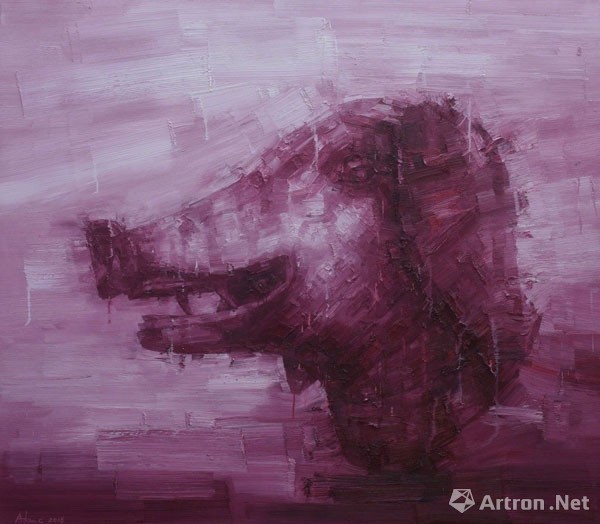
Adam Chang
Chinese Zodiac - Pig, 2015
Nanda\Hobbs
Dirty, fat-headed, unavoidably traif—the poor pig has been much maligned in Western culture. But tonight, Porky will get his comeuppance. To ring in the Lunar New Year, millions of people around the world will set off fireworks, exchange red envelopes filled with cash gifts, and feast with their families. 2019 is the Year of the Pig, bringing with it extra reason to celebrate: Among the 12 animals represented in the Chinese zodiac, the pig—the last in the cycle—promises wealth and good fortune.
How did the pig come to be associated with such prosperity in China? As a favorite food among all social classes, it symbolically represents feasting. Its vaunted status is further solidified by its inclusion in the character for home, jiā, which shows a stylized depiction of pig under a roof. In fact, the animal has long been domesticated in China, and it was common for pigs to live with rural families. The pig, that pivotal symbol of sustenance and wealth, has thus been widely represented in Chinese art over the last 2,000 years.

While the animal may offer families a tangible source of food and income during their lifetimes, in art, the pig has often come to the aid of the deceased. It was a common practice to place small pigs sculpted in precious jade or soapstone in the hands of the dead, a well-wishing expression for wealth in the afterlife. A superbly preserved example dating from the ancient Zhou dynasty (ca. 1045–256 B.C.E.)—only its little blackened snout showing any signs of age—reveals the intimate nature of such objects, the compactly supine animal measuring only 4.75 inches long. The popularity of this ritual endured for hundreds of years with few changes. A remarkably similar jade pig from the Eastern Han dynasty (25–220 C.E.) measures roughly the same size, and shows the animal in the exact same recumbent position.
More frequently, however, the humble pig endows maximum fortune when in concert with the rest of the animals that make up the dozen zodiac signs. The fortune-bearing symbols decorating one exquisite damask woman's robefrom the 19th century must have given its wearer confidence: Each zodiac animal depicted on the garment, woven in lucky red thread, represents the order of the 12 earthly branches, along with figures showing the attributes of the Daoist immortals.
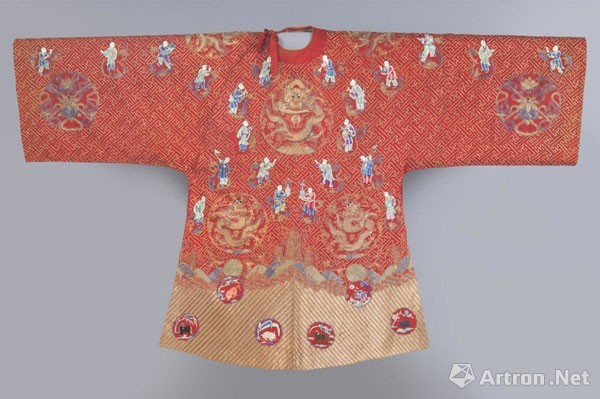
Woman's Robe, 19th century. Courtesy of the Philadelphia Museum of Art.
I recently visited the newly renovated Chinese galleries at the Philadelphia Museum of Art, where I spoke with Hiromi Kinoshita, associate curator for Chinese art. She peered at a set of 12 earthenware figurines from the Tang dynasty (618–907), which place the heads of zodiac animals on the bodies of court officials. While they were originally painted in bright colors, the figures are now an austere white. Such figurines were common accoutrements for the afterlife, found in burial tombs spanning the course of many dynasties. (A brightly colored 18th-century set crafted in delicate porcelain evinces a certain levity absent from the earlier, paint-chipped versions, and seems to reflect the European vogue for porcelain figurines.) This modestly sized set, Kinoshita explained, was made for the tomb of a middle-ranking official; archeologists note how it was strategically placed around his body. Unlike the terracotta warrior figures or servants that would accompany the well-to-do in the afterlife, the zodiac figurines served an important cosmological purpose—a type of spiritual alignment that would bring "good vibes" to the tomb, Kinoshita said.
But they're not merely good-luck symbols, she explained. A more apt word to describe the function of the zodiac figurines, according to Kinoshita, is "auspicious." The zodiac is "not just about luck," she said. "It's about making yourself align with everything, because we're just one part of the whole universe."
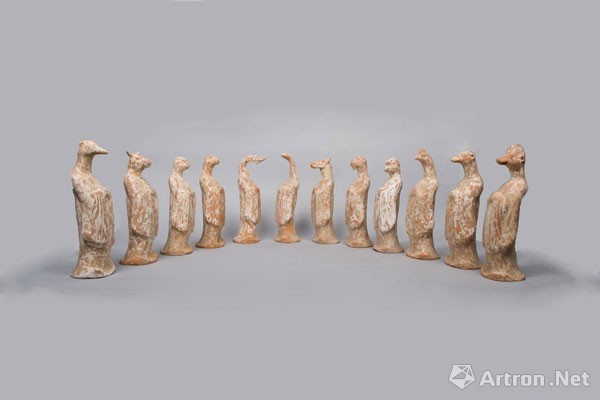
The power of these cosmological ideas carries on today; the zodiac animals still play a significant role of "alignment" in Chinese culture: They are associated with directions, times of the day, and certain constellations. Like the Western zodiac, they are used to read people's characters and predict their fortunes. To that end, each animal is imbued with particular characteristics, and artists throughout the centuries have taken pains to individualize each figure in a set.
One superb group of jade zodiac figures from the Qing dynasty in the 18th century shows the beasts in 12 different postures, each with a different accessory in their hands, from fans to whisks to staffs. Even though jade is one of the most difficult materials to carve, the artist made sure to give each figure a distinct personality.
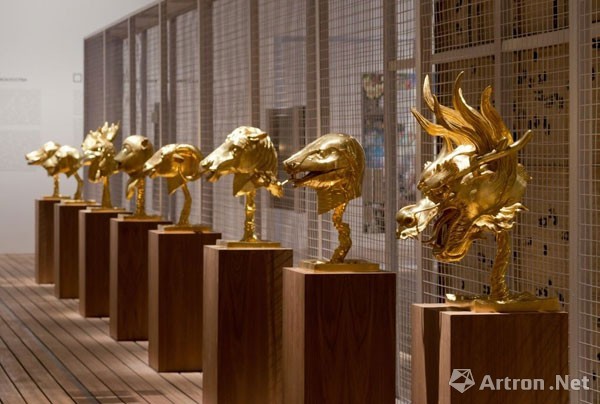
Ai Weiwei
Circle of Animals / Zodiac Heads, 2010
"Personal Choice: Collectors' Selections from their own Collections" at Garage Museum of Contemporary Art, Moscow (2014)
Westerners who obsessively follow their horoscopes know that the characteristics associated with their zodiac sign are no laughing matter. The same is true of the Chinese zodiac; those who take stock in such traditions "really do believe the attributes of that year's symbol will come out in a person," Kinoshita said. (The Western equivalent of the pig, for those checking their star charts, is Scorpio.) But the traits associated with the pig might surprise you: They are considered to be single-minded and hard-working; compassionate and generous; loving and devoted romantic partners; brave and determined, but independent. But beware: Pigs are also known to be too trusting, and thus easily fooled.
While the characteristics and formal qualities of the pig have largely remained consistent throughout China's incredible and enduring history, contemporary Chinese artists are taking on the loaded symbolism of the zodiac to probe socially- and politically-charged issues relating to Chinese identity.
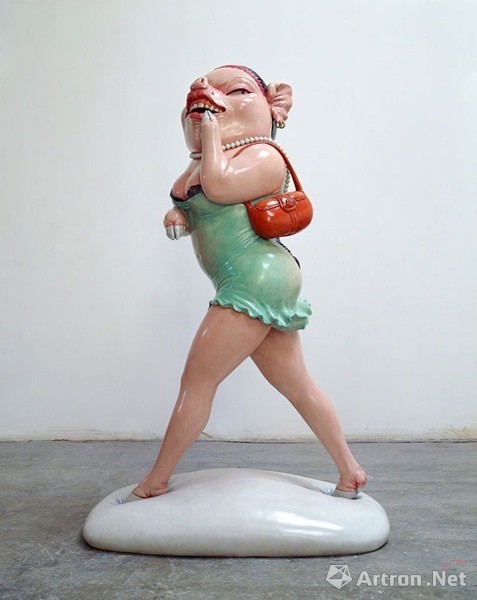
Chen Wenling
Happy Life No. 21, 2003
Contemporary by Angela Li
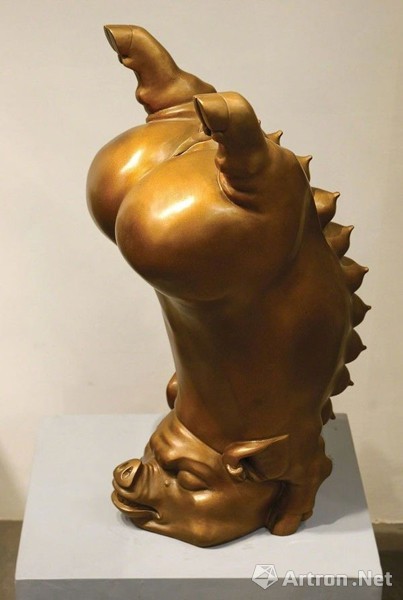
Chen Wenling
Pig, 2005
M. Sutherland Fine Arts
For his Circle of Animals / Zodiac Heads (2011),
Ai Weiwei
comments on the global reach of the Chinese zodiac while questioning colonial histories of looting and repatriation. For the public sculpture project, he recreated, in an oversized scale, 12 bronze zodiac heads that once guarded the clock fountain at an imperial retreat. Those were looted by French and British troops in the 19th century, with several of them sold at European auction houses in the 21st century.
Chen Wenling
, on the other hand, frequently invokes the pig on its own as a stand-in for human depravity. He plays on the negative associations of the pig—greed, gluttony, sloth, sexual promiscuity—often propagated in the West. Grotesque, bronze sculptures like Happy Life No. 21 (2003) shows a pig-woman strutting with the air of a prostitute, her lacy bra popping out of a deviously short dress.
Ai and Chen's projects suggest that how the pig will come to be represented in Chinese art for generations to come is up in the air: Tradition now has to contend with a scurrilous globalism. But it doesn't have to be East versus West, pig versus Scorpio—we can all strive for the cosmological "oneness" promised by an astute reading of the signs, and hope for an auspicious Year of the Pig, with all of the old blessings in tow.
(责任编辑:陈思竹[已离职])
注:本站上发表的所有内容,均为原作者的观点,不代表雅昌艺术网的立场,也不代表雅昌艺术网的价值判断。
 张瀚文:以物质媒介具象化精神世界
张瀚文:以物质媒介具象化精神世界 吕晓:北京画院两个中心十年 跨学科带来齐白石研究新突破
吕晓:北京画院两个中心十年 跨学科带来齐白石研究新突破 “纤维”提问2022:存在何“缓”?
“纤维”提问2022:存在何“缓”? 一级文物逾半数!部分仅展20天!辽博秋季大展聚焦古代文人的园中雅趣
一级文物逾半数!部分仅展20天!辽博秋季大展聚焦古代文人的园中雅趣
全部评论 (0)